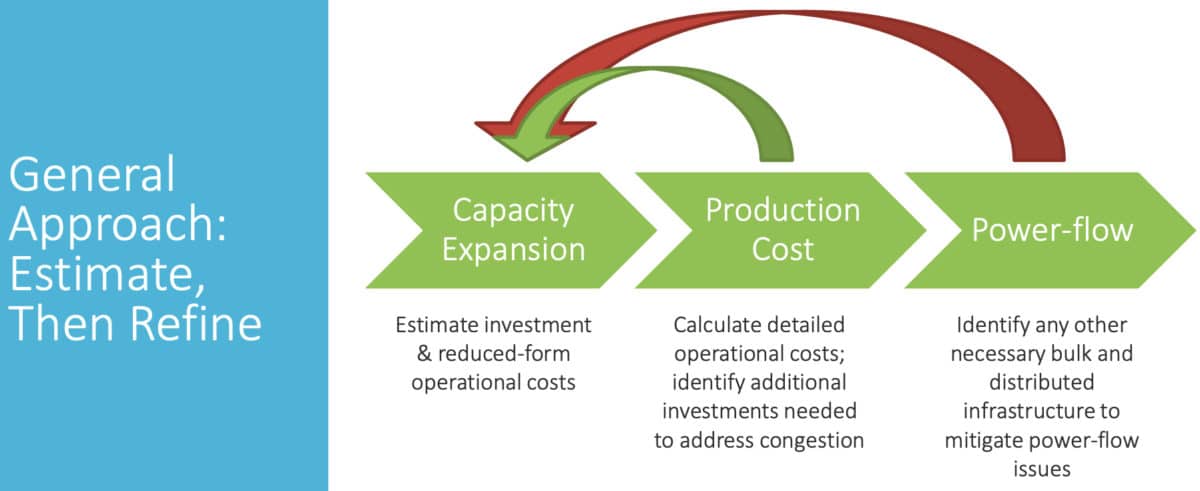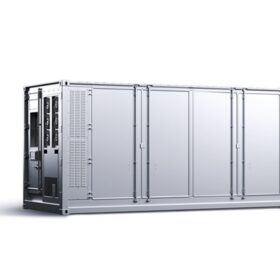Arizona State University’s initial plan for a utility modeling tool that it will donate to state regulators does not include a capacity expansion module, which is the starting point for developing a 15-year utility resource plan.
Without that module (the first green shape in the image above), the Arizona Corporation Commission (ACC) could not check the outputs of 15-year plans submitted by utilities, nor develop independent 15-year plans to compare against the utilities’ plans.
The Arizona State University team currently plans to develop only a production cost analysis tool (the second green component above) and a reliability analysis tool (which may overlap with the third green component above)—leaving out the capacity expansion analysis at the beginning.
The university team says it could create a capacity expansion tool, and asks “can this assist ACC to evaluate [utility] integrated resource plans?”
Regulatory value of a utility model
A complete utility model that starts with capacity expansion analysis would enable the ACC to hire an expert to run the model, using inputs that the ACC deemed valid (e.g., for future costs of solar and storage). That way, the ACC could check the outputs of a 15-year resource plan submitted by a utility, or develop its own resource plan from scratch, letting the model optimize across all potential generating sources.
That capability relates to Commissioner Sandra Kennedy’s expectation, in a letter last February, for modeling the integration of various generating sources at different levels:
Arizona State University (ASU) has offered a tool for modeling and evaluating the integration of various types of electric power generating sources at different levels into the grid in Arizona, at no cost to the Commission. It would be a useful, unbiased, and objective modeling tool to assist Commission Staff and the Commissioners, especially in determining how Arizona’s electric grid could handle the phasing in of more renewable energy sources as well as the retirement of various coal and natural gas-fired facilities.”
Arizona regulators last March accepted ASU’s offer to develop a modeling tool, as they work to gain better insight into the state’s renewable potential.
Fossil-heavy 15-year plans
Arizona’s three investor-owned utilities are now operating without updated resource plans, after Arizona regulators voted in March 2018 not to acknowledge the gas-heavy plans they submitted in 2017, suggesting that utilities instead aim for 80% clean energy by 2050.
Utilities in Arizona and 32 other states are required to periodically develop a long-term “integrated resource plan” (IRP) to project how they will meet future demand for electricity. To do so, a utility uses a model that can optimize across all resources to identify the least-cost resource mix.
But some utilities favor fossil-fired generation in their plans, regardless of its higher cost—for example, by using high assumptions for solar costs (TVA, Dominion Virginia), partially disabling their model (Duke Energy), or not evaluating flexible solar generation (Georgia Power).
State regulators typically lack access to a utility model and modeling expertise, which together would enable them to develop a resource plan independent of the one submitted by a utility.
The ASU team and its modeling project
The Arizona State University (ASU) model is being developed by ASU’s Lightworks initiative, which aims to harness solar energy for “solving urgent problems affecting our planet,” Lightworks Director Gary Dirks states on the initiative’s website. Dr. Dirks, formerly president of BP Asia-Pacific and BP China, leads a team of six working on the utility modeling tool.
Developing a utility model is a complex undertaking. At the same time, every existing utility model was originally built from scratch, and at least two have been developed recently: the Encompass model by Anchor Systems, and the open-source Switch model. If the ASU team develops a utility model complete with a capacity expansion component, its model will join a small pantheon of these powerful tools.
This content is protected by copyright and may not be reused. If you want to cooperate with us and would like to reuse some of our content, please contact: editors@pv-magazine.com.







Including an infrastructure planning model in the suite would be hugely valuable for charting a long-term path forward. Grid infrastructure lasts for several decades; taking grid assets as a given is very limiting for finding low-cost and reliable pathways for transitioning to a sustainable future.
I don’t know what the ASU team has in mind for software development, but I’d encourage them to reuse, extend, and/or customize existing open source tools if possible & practical. Some problems fundamentally require new models (for a variety of reasons), but I encourage people to think critically, do background research and consider the most efficient route to achieve their goals rather than jumping to the conclusion of writing a new model from scratch.
The benefits of working with and extending open source tools are three-fold. 1) Working from an existing toolbox typically yields a higher quality solution faster and more efficiently than starting from scratch, allowing human resources to be focused on usability, QA/QC, or extending the cutting edge of modeling features, 2) Working with software that has ongoing public review by a community of energy modeling experts decreases the chance of bugs going unnoticed, 3) Any improvements shared back to the community can have a multiplier effect for global emission reductions, allowing other people in other regions to plan clean energy transitions more accurately & efficiently.
Relevant open source models including Switch, PyPSA, E4ST, and more are listed at https://wiki.openmod-initiative.org/wiki/Open_Models
Historically, energy modelers and policy analysts have had a tendency to write new models from scratch, rather than working together to establish common methods and standards. This resulted in a plethora of disparate models and datasets, many of which were relatively small or lacked general-purpose features because each team had limited resources and often worked in relative isolation. I’m hopeful that these practices are starting to shift to people working together to achieve greater things. To the extent we can bring mutual aid and collaboration to bear on tackling global warming, the more effective we will all be.
Related readings:
• Energy systems modeling for twenty-first century energy challenges. https://doi.org/10.1016/j.rser.2014.02.003
• Consulting with energy scenarios: Requirements for scientific policy advice. https://en.acatech.de/publication/consulting-with-energy-scenarios-requirements-for-scientific-policy-advice/
“But some utilities favor fossil-fired generation in their plans, regardless of its higher cost—for example, by using high assumptions for solar costs (TVA, Dominion Virginia), partially disabling their model (Duke Energy), or not evaluating flexible solar generation (Georgia Power).”
The thing killing “…using high assumptions for solar costs…” is the competitive bid process. Developers are coming in with bids for solar PV, wind, a mix of both AND energy storage as part of the project for less than continuing to run an old coal fired plant. On the west coast and southwest Duke Energy likes its solar PV and wind generation facilities. On the east coast and northeast, Duke likes its commodity fueled generation plants that Duke wants to extend their operating life using ACE 20 as an excuse. If entities like Duke Energy or NRG Energy miss a step here, they will be trying to catch up to the “others” who use competitive bidding for new infrastructure creating the distributed non-fueled generation with energy storage for less than (ACE 20 embracing) electric utilities. Duke and NRG could end up running, hobbled by their own pants around their ankles, trying to catch up to the utilities counting on low competitive bids creating their revenue stream, instead of lobbyists driven subsidies for old worn out generation facilities.
It might be an easier and more functional move to adopt a SCADA system which could be used to derive electricity demand and use profiles for particular areas, create graphs, reports and statistical analysis of generation, the generation types, when to use, when NOT to use, give generation facilities a grid efficiency and worth based on prior performance. In some areas of the country like CAISO in California, SCADA is the driving force keeping the grid up during storm fronts, wind lapses and temperature spikes creating higher grid demands. Add all three of these things together, without the prediction properties of a SCADA system, it would be impossible to keep the grid out of cascading failures.